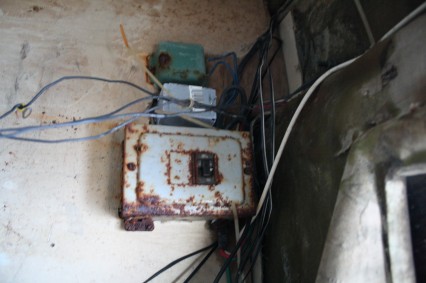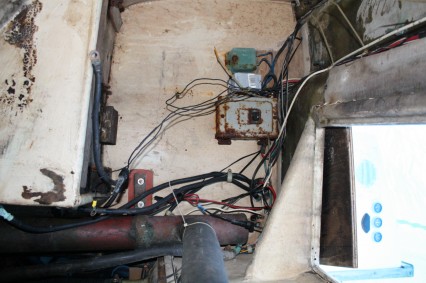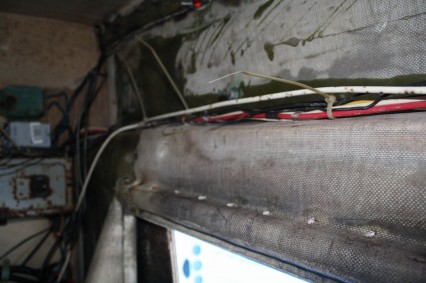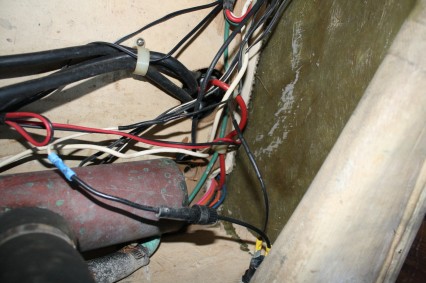AC System
Image Gallery
Research
- AC = Alternating Current
- The AC system on most cruising boats is generally quite simple. Essentially, there is likely to be just a half-dozen circuits (Cruising Handbook, p. 189)
- …it’s nice to have 110V AC power even for a short time…it’s generally easier and less expensive to use shore power when it’s available. (Upgrading the Cruising Sailboat, p. 280)
- Alternating current is as different from direct current as a bear is from a bunny….obvious distinction on a boat is that the AC voltage will be 10 times higher than the DC voltage, but the nature of AC is also fundamentally different….Direct current is, by definition, a one-way flow of electrons. With AC, on the other hand, the electrons don’t flow, they vacillate...When you flip the switch to turn on a light ashore, electrons start through the circuit just like DC for an instant, but at the generator the positive pole of the spinning magnet is followed by the negative pole, which induces the electrons to flow in the opposite direction. Just as the current starts to flow in the new direction, along comes the positive pole and reverses the direction again. (This Old Boat, p. 304)
Breakers & Fuses – AC System
Dock Cord
- The size of the extension cord from the AC outlet on the dock to the receptacle on your boat depends on the amount of juice you need. Most boats in the 30 – 40’ range use 30-amp wire, though some opt for the larger 50-amp. Good quality connectors…should be used on either end (Upgrading the Cruising Sailboat, p. 280)
- The nature of a shore-power cord is such that it has plugs at both ends. Connections using plugs are not as reliable as bolted connections. If either plug makes a poor fit or has corroded pins or sockets, resistance will be created, which then creates heat – the great the current flow, the more heat. The resistance may also result in arcing. In both cases (heat and arching), the end result may be a fire for which the various over-current devices in the circuit provide no protection. The higher the current flow, the greater is the probability of a fire. These kinds of fires are not that uncommon, particularly with AC-loaded boats, so be warned and pay close attention to the condition of shore-power cords and inlets: replace any that have corroded, pitted, or blackened pins or sockets. (Cruising Handbook, p. 187)
Grounding
Isolators
- Isolation Transformer – Shore power flowing through one side of an isolation transformer induces AC power on the other side that energizes the boat’s AC system, but there is no direct electrical connection between the boat’s AC system and shore. The DC system is likewise isolated from shore, eliminating external galvanic and stray-current corrosion as effectively as unplugging. Isolation transformers also eliminate most polarity concerns, but because they are big, heavy (200 lb.), and expensive, they are rarely installed on modest sailboats. (Sailboat Electrics Simplified, p. 149)
- Galvanic Isolator – the galvanic isolator is simply a pair of diodes connected in parallel to a second pair conducting the opposite direction. Since it takes about 0.6 volts to “push the gate open” (ie.., cause a diode to become conductive), two diodes in series block all current flow unless the voltage exceeds about 1.2 volts. Galvanic voltages between underwater metals are lower than this, so no current flows. The voltage of most stray currents, by the time it reaches your boat through the water, will also be too low to cause the diodes to pass a current. Opposing pairs of diodes pass current in both directions, so both AC and DC flows freely through the isolator once the diodes become conductive. Galvanic isolators need hefty diodes able to carry short-circuit amperage – up to 3,000 amps in a 30-amp circuit – long enough for the circuit breaker to trip. Unfortunately, not all isolators have this capability. Insert the galvanic isolator into the green wire as soon as it comes aboard to prevent unknown connections between the AC grounding wire and the DC systems from allowing currents to bypass the isolator. (Sailboat Electrics Simplified, p. 149)
Monitoring
Outlet & Inlet Fittings
- Outlets – AC outlets are all polarized….White goes with silver, so the black wire, the hot one, connects to the opposite terminal, usually brass but sometimes dark. The green terminal is fore the green grounding wire…do not loop the stripped wire end under the terminal screws on boat outlets. Also the spring-clip attachments found on lots of outlets are for solid wire, which you are not using. Commercial-grade outlets with screw-tightened clamps are a good choice and you can attach stripped wire ends directly to them. Otherwise crimp ring terminals to the ends, or locking spade terminals if the terminal screws in the outlet are captive. (This Old Boat, p. 307)
- Inlet Fitting – the inlet on your boat should be weather tight when connected and when disconnect. Screw-on caps are more secure than those sealed with spring pressure. A high-quality bronze or stainless steel fitting costs only a few dollars more than the plastic variety, but should last the life of the boat. Located the inlet where it is convenient but safely out of the way. Mount it as high as possible The backside of the inlet should be well ventilated and not at risk of mechanical damage. (Sailboat Electrics Simplified, p. 144)
- Because the 30 amp locking receptacle has become the norm at most North American and Caribbean marinas, configuring your AC system for 30 amps avoids the compatibility problems that will plague you if you arrive with a straight-blade 15 amp cord. The power cord is the first in the train of components to safely power AC appliances board…From the dock to the boat you need a power cord rated for the amperage of the dock outlet (#10 AWG or larger for 30 amp service) and carrying a hard-service rating of SO, ST, or STO to withstand submersion, abrasion, exposure, and strain. (This Old Boat, p. 306)
- The boat end of your cord should attach with a sealing collar to weatherproof the inlet…should be located as high on your boat as is practical and not more than 10 feet (wire distance) from the boat’s main AC circuit breaker. This wire, protected only by the 30 amp breaker ashore, must also be at least #10 AWG. (This Old Boat, p. 306)
- Without air conditioning, a single 30-amp inlet is almost always adequate. If air conditioning is installed, a single 50-amp inlet generally handles the boat’s entire AC load; however I recommend separating out the air conditioner and having two independent 30-amp inlets – one running the air conditioner and the other the rest of the boat’s AC circuits. Although the two independent 30-amp circuits create a modest increase in complexity over a single 50-amp inlets, there are two good reasons for this approach: 1) cost, weight, and ease of use – 30 amp shore power cords are well under 1/2 the price, 1/2 the weight, and 1/2 the bulk of same-length 50-amp cord 2) flexibility – with three or four adapters, a 30-amp cord can be plugged in just about anywhere. These adapters are also much cheaper than adapters for 50-amp cords. For times when only one 30amp inlet is available, the boat’s AC selector switch can be configured to line up one o the inlets with all the boat’s C circuits. The shore-power cord cannot support all the loads at once, but at least the boat owner can determine which ones to use. (Cruising Handbook, p. 189)
- The female receptacle should be located somewhere on deck where it is relatively free from spray and other sources of moisture. A common location is on the side of the footwell, perhaps near the after end of the cockpit. (Upgrading the Cruising Sailboat, p. 280)
- Regarding a shore power connection, the choice (in the US) is between a 30- and a 50-amp inlet (in Europe, it is commonly 16 amps or less). (Cruising Handbook, p. 189)
Safety
- …it should be impossible to access any bare terminals without the use of tools. This means that all junction boxes should have screwed-on – not snap-on – covers, and that any distribution panel that contains AC circuits should have at least one screw that needs to be undone to open it. (Cruising Handbook, p. 189)
- Unless boat owners know what they are doing, they should stay out of the AC circuits (primarily for safety reasons). (Cruising Handbook, p. 192)
- It must never be possible to connect two separate AC sources (e.g., shore power and an onboard AC generator) to the same circuit at the same time – expensive damage will result. To prevent this, all AC sources should come to a selector switch that lines up one at a time with the boat’s circuits. (Cruising Handbook, p. 192)




Comment Form